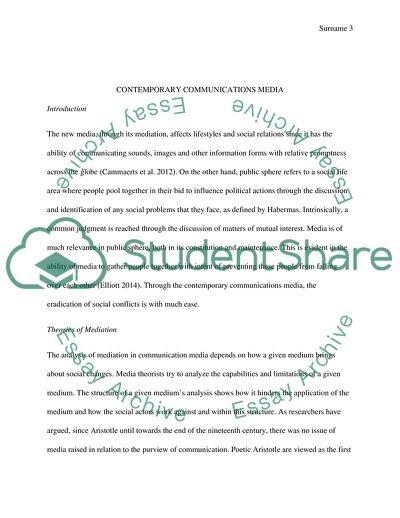Cite this document
(Contemporary Communications Media Essay Example | Topics and Well Written Essays - 1750 words, n.d.)
Contemporary Communications Media Essay Example | Topics and Well Written Essays - 1750 words. https://studentshare.org/media/1836694-discuss-and-compare-two-of-the-following-three-approaches-to-the-study-of-contemporary-communications-media-featured-in-this-unit-and-consider-which-offers-the-best-insights-into-contemporary-society-theories-of-mediation-theories-of-the-public-sphere
Contemporary Communications Media Essay Example | Topics and Well Written Essays - 1750 words. https://studentshare.org/media/1836694-discuss-and-compare-two-of-the-following-three-approaches-to-the-study-of-contemporary-communications-media-featured-in-this-unit-and-consider-which-offers-the-best-insights-into-contemporary-society-theories-of-mediation-theories-of-the-public-sphere
(Contemporary Communications Media Essay Example | Topics and Well Written Essays - 1750 Words)
Contemporary Communications Media Essay Example | Topics and Well Written Essays - 1750 Words. https://studentshare.org/media/1836694-discuss-and-compare-two-of-the-following-three-approaches-to-the-study-of-contemporary-communications-media-featured-in-this-unit-and-consider-which-offers-the-best-insights-into-contemporary-society-theories-of-mediation-theories-of-the-public-sphere.
Contemporary Communications Media Essay Example | Topics and Well Written Essays - 1750 Words. https://studentshare.org/media/1836694-discuss-and-compare-two-of-the-following-three-approaches-to-the-study-of-contemporary-communications-media-featured-in-this-unit-and-consider-which-offers-the-best-insights-into-contemporary-society-theories-of-mediation-theories-of-the-public-sphere.
“Contemporary Communications Media Essay Example | Topics and Well Written Essays - 1750 Words”. https://studentshare.org/media/1836694-discuss-and-compare-two-of-the-following-three-approaches-to-the-study-of-contemporary-communications-media-featured-in-this-unit-and-consider-which-offers-the-best-insights-into-contemporary-society-theories-of-mediation-theories-of-the-public-sphere.


